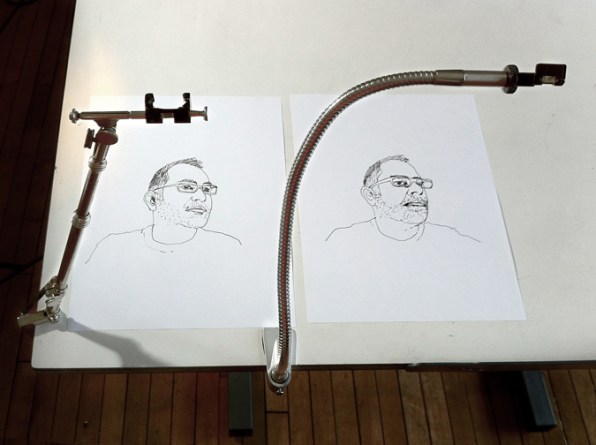How to Get Your Drawing Tool Buttons Back in Autocad
It's a widely held belief that the Old Masters were exactly that: masters, such as DA Vinci and Vermeer, who multicolor in flawlessly precise freehand. At that place are savants with steady men, no more question. But thither are other techniques to study, which David Hockney (an artist of our age WHO as wel pioneered iPad artistic production), expounds on in Secret Noesis: Rediscovering the Lost Techniques of the Old Edgar Lee Masters, in which he lays out exactly how European painters used mirrors and lenses to create their compositionally perfect portraits.
That astounded Golan Levin, an interaction clothes designer and a tech performance creative person of sorts–and indefinite of Fast Company's people shaping the future of design in 2012. Why? "Generally because information technology seemed like a truth, simply none of my colleagues talked about it," he tells Co.Purpose. Levin teaches at Carnegie Mellon and also sits on the admission faculty. "All these students come to me from falsetto school day, and they think fine art equals painting, and painting equals realistic picture. They'rhenium being set up to trust they need superhuman powers."
Pablo Garcia, an art prof at the School of the Art Constitute in Chicago, has been hip to the (controversial) idea for approximately years and has concentrated an extensive collection of optics. He offered to let Levin try verboten a camera lucida, one of the tools Hockney says the Old Masters used to appropriate their subjects more realistically. Levin loved it, and the brace decided to make a 21st-100 version.

A camera lucida is a simple political machine: A small prism reflects the image of the subject and then the witness can see their own hand, asset the look-alike, and trace a more accurate rendering onto the newspaper publisher. The issue isn't far murder from the Google Glassful video demos we've been seeing. At that place are layers of images available in your line of vision–for you to manipulation in some smart way of life. But the only lucidas stock-still available are collectibles, and run a damage tag north of $300–more than Levin and Garcia believed college students would pay. As it turns KO'd, manufacturing sporty several lucidas costs $20,000, simply each extra prism costs just pennies.
Which is why the NeoLucida sells for $30. It's clear for Kickstarter. Since launching the product on May 8, Levin and Garcia are already earshot from people who missed kayoed on the first 2,500 they made uncommitted. But unlike just about other runaway Kickstarter hits, this isn't–or wasn't–supposed to be a business. "This whole affair is a operation, or an intervention, or honourable art," Levin says. Luckily, the protrude had enough demand and interest so that just two days after going loaded, Levin and Garcia confirmed that thither leave be an bottomless second production run, conducted by professional manufacturers.
The personal effects of getting the NeoLucidas out into the market should be intriguing. Animators, filmmakers, and diagram-mappers are all groups that Levin and Garcia quotatio As logical customers. Because for all the advancements we get with graphic illustration and photography, people still want roll up their sleeves and draw poker like an gray-headed master.
The picture has already raised some $400,000, far beyond its goal of $15,000. Stomach the campaign Here.
How to Get Your Drawing Tool Buttons Back in Autocad
Source: https://www.fastcompany.com/1672559/kickstarting-a-30-optical-tool-for-drawing-with-camera-like-accuracy
0 Response to "How to Get Your Drawing Tool Buttons Back in Autocad"
Post a Comment